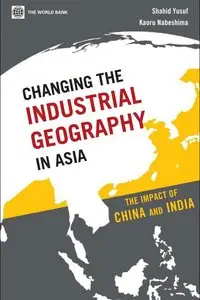Changing the Industrial Geography in Asia:
The Impact of China and India by Shahid Yusuf and Kaoru Nabeshima
Publisher: World Bank Publications | 2010 | ISBN-10: 0821382403 | ISBN-13: 978 0821382400 | English | PDF | 344 pages | 90.44 Mb
The Impact of China and India by Shahid Yusuf and Kaoru Nabeshima
Publisher: World Bank Publications | 2010 | ISBN-10: 0821382403 | ISBN-13: 978 0821382400 | English | PDF | 344 pages | 90.44 Mb
A GREAT BURST OF GLOBALIZATION brought the 20th century to a close, creating upheaval in the world economy from roughly 1995 to 2008. And now, with the new century barely commenced, a second upheaval is in the offing following the severe financial crisis that plunged the global economy into recession in 2008-09. The first upheaval witnessed a massive migration of manufacturing and certain business services that transformed Asia into the industrial heartland of the world. The second upheaval will likely consolidate Asia's industrial preeminence and could result in a concentration of industrial activities in the two most populous and fastest growing Asian economies - China and India.
As the two Asian giants become the industrial equals of the United States, Germany, and Japan, the ramifications will affect trade and growth worldwide, the future of development in China and India, and industrialization throughout Asia. Changing the Industrial Geography in Asia: The Impact of China and India examines these developments, focusing specifically on China and India. Its analysis and conclusions will be of particular interest to policy makers and academics, as well as anyone with an interest in the impacts of China and India on Asia's industrial activities.
Review
“Changing the Industrial Geography in Asia is rich in detailed analysis of the continuing transformation of the manufacturing sector in Asia, both in terms of its moving geography and its composition. For those interested in understanding the prospects of post–financial crisis Asia, this book is a must read. It is a refreshing return to economic fundamentals, including the new problems of climate change and dwindling energy resources, and will remain the leading reference on Asian transformation for a long time to come.”
–RAKESH MOHAN, Professor in the Practice of International Economics and Finance, Yale School of Management; Senior Fellow, Jackson Institute of Global Affairs, Yale University; former Deputy Governor, Reserve Bank of India
The authors consolidate a remarkable amount of data and analysis on the industrial structure of Asia and its emergence as the industrial center of the global economy. –BARRY BOSWORTH, Senior Fellow, The Brookings Institution



